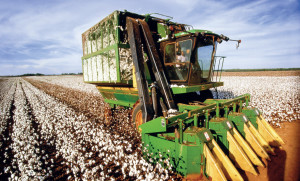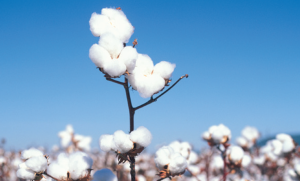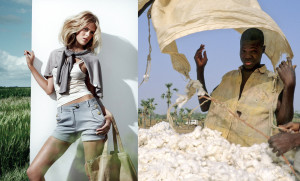Beating about the bush
Even professionals active in the field of fashion may not know that cotton, which is a natural fibre, is not at the same time an ecological fibre. The cultivation and processing of conventional cotton, which is the most commonly used type of cotton in clothing industry, is one of the major ecological threats in the world. Water problem Conventional cotton is a real problem for the environment. Cotton plantations necessary for the production of our clothing exploit nature and lead to degeneration of local communities which inhabit the areas next to the plantations. Despite the fact that 2.5% of cultivated area in the world is dedicated for cotton, as much as 6% of the global usage of fresh water is assigned to this industry. Similarly to every industrial production, overexploitation of this most precious natural resource contributes to desertification of Earth, ecological disasters and devaluation of many areas on Earth. One of the most shocking examples of depletion of water resources caused by cotton plantations is the Aral Sea in Uzbekistan, which until 1960 was ranked fourth in the world in terms of size. Today, the lake area is only 25% of the initial size, and it holds only 10% of the initial volume of water32. Due to rapacious water mangement for cotton bushes, the shore of that lake suffers from serious economic and ecological problems. Lack of water means downturn of local economy: no possibility to continue plantations, also of other plants, high unemployment rate and deterioration of living conditions. Water discharge from the Aral Sea by irrigation systems leading, among others, to cotton plantations, is perceived as one of the biggest ecological disasters in the world. This issue has been described in many publications as a textbook example of wrong water resources management and disastrous influence of cotton production on ecosystem.
31 UNESCO-IHE, Institute for Water Education, The Water Footprint of Cotton Consumption, DADelft 2005
32 [online:] http://www.nasa.gov/mission_pages/landsat/news/40th-top10-aralsea.html
daccess date: February 2013

Harmful chemicals
Countries such as China, the USA, Pakistan, India, Uzbekistan or Turkey33, where cotton plantations are located, not only suffer from lack of water, but also from its pollution. An overwhelming volume of chemicals used for accelerating the vegetation cycle and as an insect repellent, are discharged into groundwater and pollute nearby ecosystems. Among postproduction waste are toxics used for defoliation (process of removing leaves from the plant) and growth stimulation. Environmental pollution due to cotton production in the context of responsible fashion is extremely significant. The volume of pesticides used for cotton production is between 10 and 25% of their global usage34. Without them, plantations would lack their industrial character, and their profitability would remain in doubt. For a better understanding of negative effects of pesticides, it is worth mentioning the information provided by Bayer company in the online manual of Prep 720 – one of the substances accelerating growth of, inter alia, cotton bushes. The company specifies that the pesticide cannot be poured into rivers and lakes, since it is dangerous to fish. What is even more interesting, the company warns that after spraying the plants one cannot enter the field for the next two days and the body should be protected against contacting this substance. The leaflet’s header includes the word “poison”. Prep 720 is a chemical permitted for clothing production. It is not difficult to figure out that some of this substance remains in the fibres used for our clothing.
33 [online:] www.cotton.org acces date: January 2013
34 [online:] http://www.ota.com/organic/environment/cotton_environment.html
acces date: January 2013
[online:] http://www.panna.org/resources/cotton/ access date: Febraury 2013
Also during subsequent stages of producing conventional cotton yarn, for cleaning, bleaching and dyeing, a large volume of water is used and polluted – from 7 thousand to 29 thousand liters/1kg of cotton35. Among substances polluting water while processing cotton there are also harmful for our health chemicals, containing copper, zink and heavy metals. These harmful substances build up in the fibres of produced clothing36.

Health issue
Who would think that the kid’s cotton garment may be the cause of allergy or skin irritation? But this may be the cause. There have been only a few studies investigating the quality of clothes we wear. We should be aware that among insecticides used at the cotton plantation is potassium cyanide, extremely harmful for our nervous system, while to protect the cotton fabric from dirt and folding formaldehyde is often used in industrial production. To make the issues more familiar, the identification of dangers coming from formaldehyde is described by The Central Institute of Labour Protection – the Polish Research Institute: “Toxic or harmful substance, a corrosive or irritant (depending on its concentration). Limited evidence of carcinogenicity. At concentrations over 25% it is toxic through respiratory tracts, skin and by swallowing. May cause allergy while in skin contact” 37. Surprisingly, The Central Institute of Labour Protection – the Polish Research Institute does not connect cancer rate with formaldehyde, while at the same time the National Institute for Occupational Safety and Health states that formaldehyde is carcinogenic38.
5 N. Cherrett, J. Barrett, A. Clamett, M. Chadwick, M.J. Chadwick, Ecological Footprint and Water
Analysis of Cotton, Hemp and Polyester, Stokholm 2005
36 WWF, “The Impact of Cotton on Freshwater Resources and Ecosystems”, 1999
The Polish Green Network, “Towards responsible Fashion”, Cracow 2012
37 [online:] www.ciop.pl/3823.html access date: January 2013
[online:] http://www.ciop.pl/11342.html access date: February 2013
38 [online:] http://www.cdc.gov/niosh/topics/formaldehyde/ access date: February 2013
The situation looks even worse when it comes to the analysis of chemicals used for defoliating cotton bushes. Herbicides come from the most popular defoliant Agent Orange (produced, inter alia, by the infamous Dow Chemical and Monsanto39), which was used during the Vietnam War as an extremely toxic chemical weapon. This herbicide may be the cause of body distortions and cancer. There are ongoing court proceedings of the victims between both sides of the armed conflict who had any contact with Agent Orange. Of course, the above mentioned substances are used within cotton industry in permitted concentrations. The question is whether ourselves we would allow them to be used?
39 Dow Chemical is identified as being partially responsible for the ecological disaster in Bhopal in 1984, when 20 000 persons died after evaporation of pesticides from the Union Carbide plant. The factory was then purchased by Dow Chemical, which persistently refuses to admit responsibility for this tragedy and to pay compensations to the victims. In 2008, the company provided pesticides which led to mass soil pollution. Monsanto is an international company in the biotechnology and organic chemistry sector. It has been criticised for many years by ecological organisations for agressive patent politics, use of deadly chemicals and promotion of GMO.

Heavy carbon footprint
The fact that the main production of conventional cotton is located in developing countries or on the areas far away from communities and other production sites, greatly affects the increase of carbon dioxide in atmosphere. In the context of climate warming, the ecological character of each production, or lack thereof, is measured by emission of CO2 to atmosphere – in order to produce 1 kg of conventioanl cotton as much as 7 kg of CO2 40 is emitted. Transportation of cotton in the global production chain is one of the factors having a negative effect on the natural environment. In the case of a single garment, from the moment of starting production to the moment of sale, it can travel even up to 50 thousand kilometres41. In addition, it must be also mentioned that excessive fuel consumption and engaging intermediaries in the entire process of such distant production also significantly influences the price of a final product, and at the same time lowers the employees’ salaries. As a result, it deepens social and economic conflicts in the regions where clothing production takes place, which, apart from the heavy carbon footprint, is another flaw of the clothing industry.
Statistical data related to cotton production42.
– 40-50 thousand tonnes of dye per year are discharged into water by the textile industry
– 20 thousand people die each year as a result of pesticide toxication
– 8 thousand is the number of different chemicals used for cotton processing
– 50% of usage of all pesticides in developing countries is assigned to cotton production.
40 M. Berners-Lee, How Bad are Bananas, London 2010
41 [online:] http://www.ekonsument.pl/s128_bawelna_konwencjonalna.html access date: December 2012
42 Information on the basis of: [online:] ekokonsument.pl, Fao.org, epa.gov, zielonasiec.pl, waterfootprint.org,
carbontrust.com, international.org, sei-international.org, usaid.gov access date: September 2012
John Baffes, Cotton Subsidies, the WTO and the Cotton Problem, World Bank 2001.
– 110 thousand tonnes of nitrogen, used for cotton production between 1997-2001, were discharged into waters by India and China
– 496 m3 of water is used for bleaching, dyeing, printing and finishing of 1 ton of cotton
– 1-6% of global use of fresh water is assigned to cotton production
– 36,1 mln of hectares in the world is taken up by cotton plantations
– 73% of global cotton production is located at specially irrigated fields
– 25 mln tonnes of conventional cotton is produced every year
– 7-29 thousand litres of water is used to produce 1 kg of cotton
– 10 thousand litres of water is used to produce 1 pair of jeans
– 2.5% of global agricultural land is assigned to cotton production

Organic cotton
It seems that not many people are aware that there is an ecological alternative to all these problems, which is ecological cotton. Ecological cotton is closely connected with eco plantations. In general, eco plantations affect natural environment to a lesser extent, because they are under special regulations from certifying institutions. Certifications provide directives which exclude nature destruction, using pesticides and impose a limit on water consumption. Furthermore, organic plantations in developing countries usually belong to smaller entities, often family run companies.
Profits coming from plantations go to local communities and support local markets, connecting people’s business with a pro environmental approach. It can be said that ecological cotton plantations have only advantages. However, in the context of capitalist competitiveness, they are less profitable than industrial plantations. It would appear that ecological initiatives do not have any chances when faced with a global supply of poducers who offer lower prices and have at their disposal a better organized distribution. Nevertheless, despite economic difficulties, research by the Ethical Fashion Forum of 2009 can come as a surprise, since it predicted that only in 2011 the need for organic cotton will grow by about 20% 43. The market value, however, was higher even earlier, because between 2008-09 it increased by 35% 44. The above-mentioned data are also confirmed by the Organic Trade Association, which stated that in 2012 the eco cotton products turnover was as high as USD 7.4 billion in comparison to only 3.2 billion (in 2008) 45. These numbers show a growing need for organic fabrics and a positive trend, maybe resulting from the changing awareness of consumers. Therefore, it is not surprising that the biggest global brands, such as Nike, H&M, C&A, Adidas, Cottonfield or Levi’s offer clothing made of ecological cotton. What is the fenomenon and the difference between ecological and industrial cotton?
Better water management
In the current global crisis connected with the lack of water, its recycling and prevention of excessive usage at the cotton plantations is one of the conditions required to receive ecological certificates. According to a 2012 report published by the UNICEF, lack of drinking water and limited access to the resources is a problem of 780 mln people46.
43 [online:] http://source.ethicalfashionforum.com/article/a-flourishing-organic-cotton-market
access date: December 2012
44 Organic Exchange, Organic Cotton Market Report 2009
45 Organic Trade Association, U.S. Organic Cotton Production & Marketing Trends, 2012
Organic Exchange, Organic Cotton Market Report 2007-2008
46 [online:] http://www.unicef.org.au/Discover/What-we-do/Water,-Sanitation-and-Hygiene/Water.aspx
access date: February 2013
Ecological priorities focus on limiting the use of water at organic cotton plantations. It happens through, inter alia, collection of rain water – special containers are installed on the roofs. The soil is protected from losing humidity by natural insulation, which is straw. Straw is formed in loose parcels and placed on the ground. It prevents water evaporation and oxidation of soil by sunlight. It is prohibited to dry any local natural reservoirs for irrigating ecological cotton plantation47. It is also required that in the entire production chain, water use should be treated as a priority and encompass the entire production cycle, including monitoring of water use in further stages of processing, until the moment of obtaining garment ready to wear.
Lack of chemicals
This is the fundamental issue in obtaining the status of an ecological plantation. Agressive chemicals are replaced with old, traditional methods at organic cotton plantations. As far as insects are concerned, instead of pesticides chili pepper, lucerne, garlic, mint or lavender are used, which also keeps at bay irritating mosquitoes and flies. Whey, manure and covering soil with organic elements, such as composter, serve as fertilisers. 48. Defoliation of plants is done by hands or through natural environmental cycles, e.g. night frosts. Awaiting for the season to change may be an expensive slowdown of production; however, advantages for environment and consumers – healthy natural environment, cotton products without chemicals – are incomparable to the ecological loss connected with conventional cotton plantation. Similar benefits come from replacing bleaching and dyeing chemicals with their organic counterparts. Natural clay and plant extracts have been known and used in textile processing in the entire world for many years. To sum up, colors obtained in this manner are equally vivid as the ones obtained as a result of conventional production. Indian fabric colors are famous for their saturation and intensity, and their use in remote places has not changed for hundreds of years.
In conclusion, the production of organic cotton may bring the same effects as conventional production, but without toxic chemicals. Organic cotton means health. Speaking of health, it should be noticed that clothes made of organic cotton are being easily granted attestations allowing their use for babies and children. In the entire production process, ecological fibres are not polluted with toxic substances, are non-allergenic and their quality is not altered. Naturally soft textiles without the characteristic formaldehyde odour are a better alternative to industrial, conventional cotton. Probably, also due to this reason, the sale of organic cotton is the most noticeable in parenting products, such as clothes for the youngest children, cotton diapers, blankets, tissues or even ear buds. In 2009 alone, the organic textiles market yielded a profit of 4.3 billion USD 49. While analysing results of supply and demand of this type of products, one may assume that organic cotton products are suitable even for the most demanding customers.
47 [online:] http://www.cefs.ncsu.edu/resources/organicproductionguide/compostingfinaljan2009.pdf
access date: November 2012
48 Ibid.
49 [online:] http://www.organic-textile.com/organiccotton.html access date: November 2012
Locally means better
There are many more people who agree with the theory saying that globalization of production brings more negative effects than postitve ones. Companies located far away from the selling points are difficult to be controlled, while long distance transportation means additional emission of the toxic carbon dioxide to the atmosphere. Money in intercontinental trade strenghtens distant management boards of corporations, instead of building safe local markets. The importance of ecological cotton in this context is significant. We can learn from practice that bio cotton is grown on smaller local plantations, which often belong to family run companies. Owners of local enterprises, known in their communities and to local authorities, due to legal and prestige reasons cannot afford to breach human rights or pollute the environment, which is a common issue in anonymous cartels of global brands that remain unpunished. Money earned by the family of an ecological farmer, instead of going out of the country, is often invested on the local market boosting the economy and development of surrounding areas.
Statistical data concerning production of organic cotton50:
– 3 years are needed for the soil to “recover” from chemicals before their owners can obtain permission for ecological plantation
– 23 thousand tonnes of ecological cotton entered the market in 2006, in the 80s first plans of organic cotton implementation were presented
– Europe is the biggest outlet for organic cotton
– USA and Turkey are the main producers of organic cotton
– 2 kg of CO2 is needed for producing 1 kg of organic cotton
– 0.09% is the percentage of organic cotton participation in global cotton production
Local company operations are profitable for all, from the employer to the employee, not only for a small group of managers.
To sum up the section on ecological cotton, it can be concluded that plantations are a proper direction for the global textile industry. Local investments, ecological solutions, good market results confirm the advantages described above and are an unquestionable argument in favour of the use of ecological element of CSR policy by clothing companies.
50 [online:] www.ams.usda.gov/AMSv1.0/getfile?dDocName=STELDEV3003494&acct=noprulemaking
access date: January 2013
International Trade Centre, Organic Cotton : An Opportunity for Trade, 2007
BioRegional Development Group, World Wide Fund for Nature – Cymru, Ecological Footprint
and Water Analysis of Cotton, Hemp and Polyester, Stockholm 2005
Ibid.
Ibid.
D. A. Dornfeld, “Green Manufacturing, Fundamentals and Applications”, New York 2013
International Trade Centre, Organic Cotton : An Opportunity for Trade, 2007

